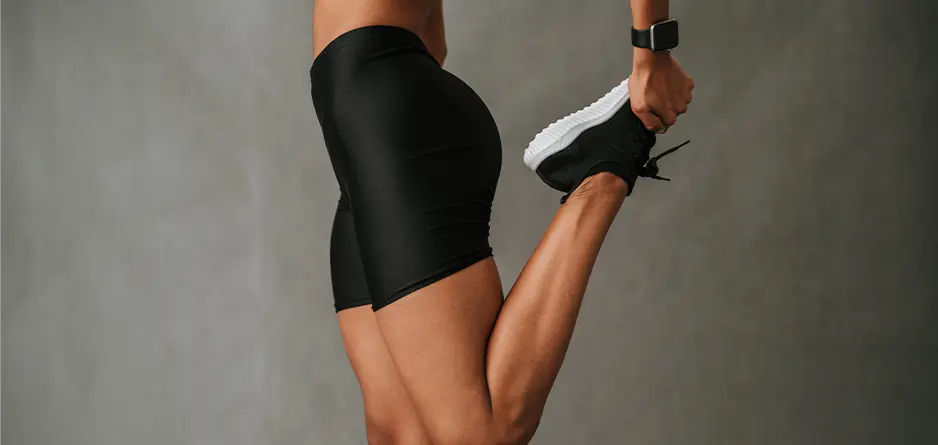Stretching vs. Strengthening: Which Prevents Leg Cramps Better?

Area
Key Takeaways:
- Both stretching and strengthening are key to preventing leg cramps. Research shows they are equally effective for building flexibility and muscle resilience.
- Develop a balanced “stretch and strengthen” routine with our science–backed exercise plan for overall muscle health and reduced cramp frequency.
- Crampeze offers targeted, multi-ingredient support, complementing exercise by promoting muscle relaxation and circulation for comprehensive cramp relief.
There’s nothing quite like the sudden, searing pain of a leg cramp to stop you in your tracks. Whether it strikes during a run or wakes you from a deep sleep, you’re left wondering: how can I stop this?
In this guide, we explore the stretching vs. strengthening debate, explaining how each contributes to preventing leg cramps. You’ll discover why a balanced approach is key and how Crampeze can offer holistic support, ensuring your legs stay comfortable and cramp-free.
Why Are My Legs Cramping?
Leg cramps are sudden, involuntary contractions of the muscle, often causing sharp pain as the muscle tightens up. Here are the most common reasons your legs might be cramping:
- Muscle Fatigue: Overworked muscles from intense exercise or prolonged activity.
- Dehydration: Not drinking enough fluids can disrupt your body’s electrolyte balance.
- Electrolyte Imbalances: Low levels of essential minerals like potassium, magnesium, or calcium.
- Muscle Tightness: Inflexible or “unstretched” muscles are more susceptible to cramping.
These cramps can affect many different parts of your leg, most commonly in the calves, shins and hamstrings.
How Stretching & Strengthening Can Prevent Leg Cramps
The good news is that by incorporating regular stretching and strengthening into your daily routine, you can significantly reduce the likelihood of painful leg cramps.
Strengthening Leg Muscles
Building leg muscle plays a key role in cramp prevention, resulting in better muscle coordination and increased resilience. Here’s why strong legs can improve your overall muscle function.
Benefits of Stretching and Strengthening
- Improved Endurance: Stronger muscles sustain activity longer and delay fatigue, which is a common cause of cramps.
- Reduced Fatigue: Muscles handle demands more efficiently, reducing exhaustion and cramping.
- Enhanced Stress Handling: Stronger muscles are more resilient and better equipped to handle physical stress without cramping.
Stretching Leg Muscles
A regular stretching routine can boost flexibility and ease stiffness. Here’s how stretching makes your muscles less susceptible to sudden contractions.
- Improved Muscle Elasticity: Lengthens muscle fibers, making them more pliable and less prone to sudden contractions.
- Increased Blood Flow: Promotes better circulation, delivering oxygen and nutrients while removing cramp-contributing waste products.
- Reduced Muscle Tension: Alleviates overall tightness, making muscles more relaxed and less likely to seize up.
Best Stretches for Cramp Prevention
- Stretch for Hamstring Cramp: To relieve a hamstring cramp, try a seated forward fold. Sit with your legs extended, then gently hinge from your hips and reach towards your toes to lengthen the back of your thighs.
- Stretch for Shin Cramp: A kneeling shin stretch can be effective for shin cramps. Kneel with your feet tucked under you, then gently lean back to stretch the front of your shins.
- Stretch for Inner Thigh Cramp: Try the butterfly stretch to relieve inner thigh cramps. Sit on the floor with the soles of your feet together, letting your knees fall open to the sides, then gently press your knees towards the floor.
Strengthening Your Legs for Cramp Resistance
- Bodyweight Squats: Stand with feet shoulder-width apart, lower hips as if sitting in a chair, keeping chest up, targeting your quads, glutes, and hamstrings.
- Lunges: Step one leg forward, bending both knees to 90 degrees, then push back to start, working your quads, glutes, and hamstrings in each leg.
- Calf Raises: Stand and slowly lift onto the balls of your feet, then lower, specifically strengthening your calf muscles.
- Wall Sit: Lean against a wall, slide down until knees are at 90 degrees, and hold, engaging your quads and glutes isometrically.
Leg Strengthening Exercises for Seniors
- Chair Squats: Slowly sit down and stand up from a chair, using your legs (and hands on knees if needed).
- Seated Leg Lifts: While seated, extend one leg straight out, hold, then lower, alternating legs.
- Wall Push-ups for Calves: Stand facing a wall, place hands on it, and perform calf raises, pushing up onto your toes.
- Glute Bridges: Lie on your back with knees bent, feet flat, and lift hips off the floor, engaging glutes for overall leg and core strength.
Choose Crampeze for Lasting Leg Cramp Relief
- Magnesium: Crucial for muscle relaxation and nerve function, helping prevent the involuntary contractions that cause cramps.
- Cramp Bark: Traditionally used to calm muscle spasms and twitches, offering direct relief for sudden cramps.
- Ginkgo Biloba: Supports healthy blood circulation to the extremities, ensuring muscles receive vital nutrients for proper function and recovery.
The Balanced Path to a Cramp-Free Life
Ultimately, the most effective way to keep those painful leg cramps at bay is a stretch and strengthen routine.
By combining consistent flexibility work with targeted muscle building, you’re creating a resilient, well-functioning system less prone to spasms. A science-backed approach also includes proper hydration, balanced nutrition, and the targeted support of a quality supplement.
Crampeze is designed to complement your leg stretching and strengthening, addressing the underlying factors that can trigger cramps even when you’re doing everything else right.
When you’re ready to take control of your comfort, explore the Crampeze range and find a store today for comprehensive leg cramp support.
References
- Pubmed.gov: Stretching before sleep reduces the frequency and severity of nocturnal leg cramps in older adults: a randomised trial
- Pubmed.gov: An Evidence-Based Review of the Pathophysiology, Treatment, and Prevention of Exercise-Associated Muscle Cramps
- Pubmed.gov: Non-drug therapies for the secondary prevention of lower limb muscle cramps







